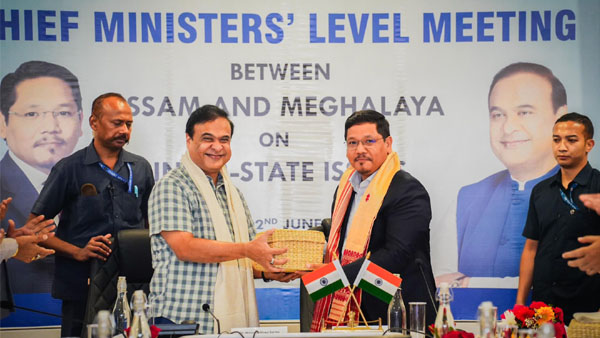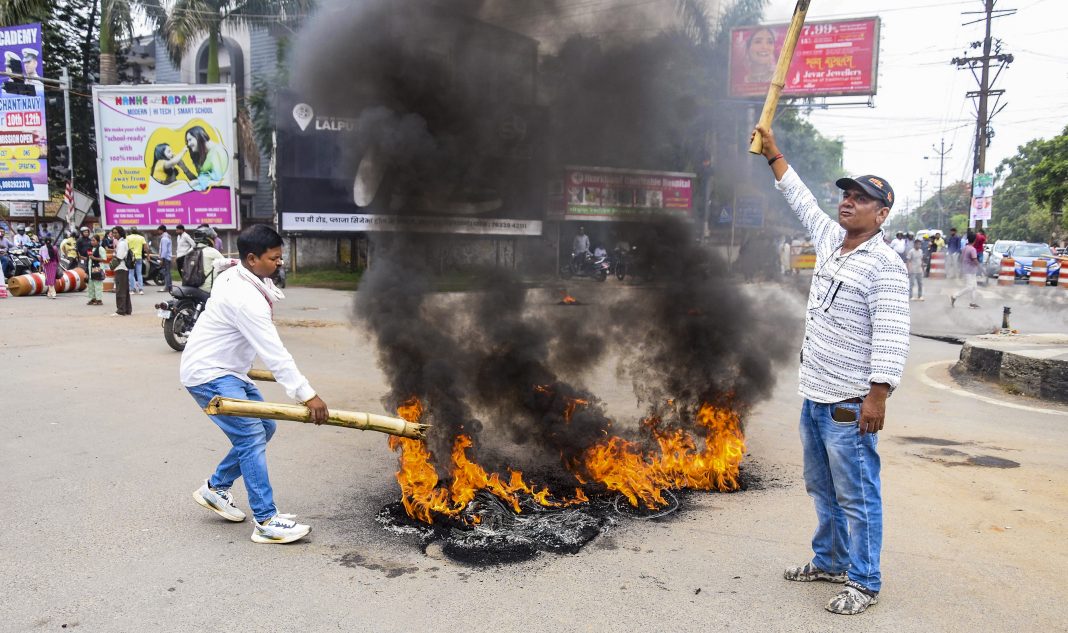By Dipak Kurmi
On the evening of June 2, the city of Guwahati played host to a landmark meeting between Assam Chief Minister Himanta Biswa Sarma and Meghalaya Chief Minister Conrad Sangma, marking a significant step toward resolving long-standing inter-state issues. The Chief Ministers’ Level Meeting, attended by key officials from both states, focused on critical areas of cooperation, including the Assam-Meghalaya border dispute, urban flooding in Guwahati, and the joint development of the Kulsi multipurpose project. The discussions underscored a shared understanding that development in Assam and Meghalaya is mutually inclusive, necessitating collaborative efforts to address challenges and unlock opportunities. As the two states commit to actionable steps—ranging from erecting boundary pillars to leveraging satellite technology for flood management—this meeting heralds a new chapter in inter-state relations, one grounded in pragmatism and mutual benefit.
The historical backdrop of Assam-Meghalaya relations has been marked by both cooperation and contention. Since Meghalaya was carved out of Assam in 1972, disputes over the inter-state boundary have persisted, rooted in differing interpretations of historical maps and administrative boundaries. These disputes span 12 areas, with six already resolved through a memorandum of understanding (MoU) signed in 2022 under the guidance of Union Home Minister Amit Shah. The unresolved issues, however, continue to fuel tensions, particularly in areas like Tarabari and Hijang near the Assam-Meghalaya border. At the June 2 meeting, both chief ministers expressed optimism about resolving these disputes amicably. Of the six previously settled areas, minor hiccups remain, but Sarma announced that boundary pillars would be erected at five of these sites—excluding Pilangkata—by August 15, coinciding with India’s Independence Day. The Pilangkata issue, he noted, would be addressed through further discussions between the deputy commissioners of the respective districts, with confidence that a resolution is imminent. For the remaining six disputed areas, both states agreed to find a mutually agreeable timeline, emphasizing fairness and dialogue with local communities.
Beyond the border dispute, the meeting tackled the pressing issue of urban flooding in Guwahati, a problem exacerbated by water flow from Meghalaya. Guwahati, Assam’s largest city, has long grappled with artificial flooding during the monsoon season, a phenomenon that disrupts lives, damages infrastructure, and hampers economic activity. Sarma highlighted that water flowing from three specific locations in Meghalaya—Khanapara, Juripar, and Jorabat—contributes significantly to this issue. This marked the first time both governments engaged in a formal discussion on the matter, with Meghalaya briefed through a detailed presentation on the water flow dynamics. To address this, the states agreed to entrust the North Eastern Space Applications Centre (NESAC) with conducting a satellite-based assessment of forest cover, water flow patterns, and areas prone to waterlogging in these regions. The mapping, expected to be completed within three months, will identify the precise sources of water flow from Meghalaya into Guwahati. The data will then be sent to the Indian Institute of Technology (IIT) Roorkee for analysis, with both governments committing to jointly implement the institute’s recommendations. This scientific approach reflects a forward-thinking strategy to mitigate flooding, ensuring that Guwahati’s residents, as well as those in Meghalaya who rely on the city for economic opportunities, benefit from improved urban resilience.
Another cornerstone of the meeting was the proposed Kulsi multipurpose project, a joint initiative aimed at harnessing the potential of the Kulsi River, which flows along the Assam-Meghalaya border. The project, which includes a 55-megawatt hydroelectric power plant and irrigation infrastructure, promises to transform the agricultural landscape of Assam’s Kamrup and Goalpara districts while fostering sustainable development in Meghalaya. Assam will fund the irrigation component, benefiting farmers in both states, while the power project will be developed collaboratively after consultations with local communities. Sarma emphasized the importance of community consent, stating that further steps would only be taken once residents are on board—a nod to the region’s history of protests against large-scale projects perceived to disrupt local ecosystems and livelihoods. The Kulsi project, if realized, could serve as a model for inter-state cooperation, balancing economic growth with environmental and social considerations. Meghalaya’s Minister of Tourism, Paul Lyngdoh, who attended the meeting, noted that the project aligns with the state’s vision of promoting agricultural productivity and clean energy, potentially boosting eco-tourism in the region.
The meeting also highlighted the broader vision of development shared by Assam and Meghalaya. Sarma and Sangma acknowledged that the progress of one state is intrinsically linked to the other, given their geographical proximity and economic interdependence. Assam, with its larger population and industrial base, relies on Meghalaya’s natural resources, including water and forest cover, which regulate the region’s climate and hydrology. Conversely, Meghalaya benefits from Assam’s infrastructure, markets, and connectivity, with Guwahati serving as a gateway for trade and commerce. This interdependence was evident in the discussions on urban flooding, where both states recognized that a solution would benefit not just Guwahati’s residents but also Meghalaya’s communities, who face similar challenges during heavy rainfall. The decision to involve NESAC and IIT Roorkee underscores a commitment to evidence-based policymaking, a departure from past ad-hoc measures that failed to address the root causes of flooding.
The presence of senior officials from both states further emphasized the meeting’s significance. Assam’s delegation included Minister of Housing & Urban Affairs Jayanta Mallabaruah, Chief Secretary Dr. Ravi Kota, and several principal secretaries, while Meghalaya was represented by Lyngdoh, Chief Secretary D.P. Wahlang, and other senior officials. Their participation ensured that the decisions taken were not merely symbolic but backed by the administrative machinery needed for implementation. Sarma thanked Sangma for visiting Guwahati and engaging on the flooding issue, noting that the discussions would contribute positively to resolving inter-state matters. Sangma, in turn, reiterated Meghalaya’s commitment to dialogue and collaboration, stating that the shared vision of development would benefit both states in the long term.
The June 2 meeting builds on a history of efforts to strengthen ties between Assam and Meghalaya. The 2022 MoU, which resolved six of the 12 border disputes, was a testament to the states’ willingness to prioritize dialogue over conflict. That agreement, facilitated by the central government, involved equal land swaps and was hailed as a step toward peace in the region. However, challenges such as deforestation, hill-cutting, and land encroachment have continued to strain relations, particularly in areas like Tarabari and Hijang. The Central Empowered Committee (CEC), a Supreme Court-appointed body, has also flagged violations in these regions, urging both states to address environmental concerns. The decision to involve NESAC in flood mapping aligns with these broader efforts, as it will also assess deforestation and its impact on water flow—a critical factor in both flooding and border disputes.
The Kulsi project, meanwhile, taps into the Northeast’s vast potential for renewable energy and agricultural development. The region, often called India’s “powerhouse” due to its numerous rivers and hilly terrain, has long been eyed for hydroelectric projects. However, past initiatives, such as the Subansiri Lower Hydroelectric Project, have faced resistance from local communities over environmental and displacement concerns. By prioritizing community engagement, Assam and Meghalaya aim to avoid similar pitfalls with the Kulsi project, ensuring that the benefits of power generation and irrigation are equitably shared. The project’s focus on clean energy also aligns with India’s national goals of achieving net-zero emissions by 2070, as outlined in the 2021 COP26 commitments.
The issue of urban flooding in Guwahati is emblematic of broader challenges facing the Northeast. Rapid urbanization, unplanned development, and climate change have exacerbated waterlogging in cities across the region, from Shillong to Imphal. Guwahati’s woes are compounded by its topography—surrounded by hills that channel rainwater into the city—and the Brahmaputra River, which often overflows during the monsoon. The involvement of NESAC and IIT Roorkee could set a precedent for other Northeastern states, offering a blueprint for addressing environmental challenges through technology and inter-state cooperation. Moreover, the data generated from this initiative could inform broader climate adaptation strategies, such as afforestation and watershed management, which are critical for the region’s ecological stability.
As Assam and Meghalaya move forward, the success of their collaboration will hinge on implementation. The erection of boundary pillars by August 15, the completion of NESAC’s mapping within three months, and the community consultations for the Kulsi project are tangible milestones that will test the states’ commitment. The involvement of local communities, as emphasized by both chief ministers, will be crucial in ensuring that development is inclusive and sustainable. For residents of the border areas, who have long borne the brunt of disputes and environmental degradation, these initiatives offer hope for a more prosperous future.
The June 2, meeting between Assam and Meghalaya is a testament to the power of dialogue in resolving complex inter-state issues. By addressing the border dispute, urban flooding, and the Kulsi project with a spirit of cooperation, the two states have laid the groundwork for shared prosperity. As Sarma noted, the discussions will contribute positively to resolving long-standing matters, paving the way for a stronger, more integrated Northeast. For the people of Assam and Meghalaya, this meeting is not just a diplomatic exercise but a promise of a better tomorrow—one where borders unite rather than divide.
(the writer can be reached at dipakkurmiglpltd@gmail.com)




